Welcome back, Norwich City. Back-to-back Championship titles sandwiched a Premier League relegation in 2019/20 – the Canaries will be looking to improve on their previous showing in the top tier this time around. You’ll recognise a few faces from their last outing in the top flight: Daniel Farke remains in charge and with a new four-year deal in his desk drawer to continue getting his tactical fingerprints all over this team; and much of the spine from the Premier League relegation season remains, with the likes of Tim Krul, Max Aarons, Todd Cantwell and Teemu Pukki all demonstrating a capability to play at this level the last time they were here. There’s no question that Norwich were deserving Championship champions after a hugely impressive season which saw them graduate with 97 points. They were the best team in the league both aesthetically and by the numbers; their expected goal difference of +30.2 was superior to anyone else in the division. 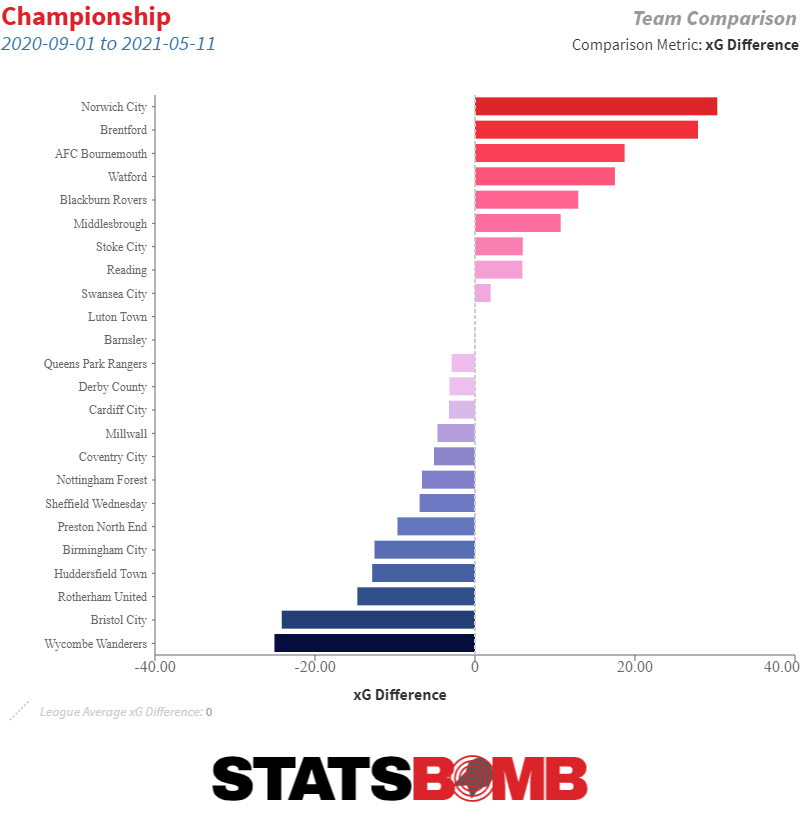 This was largely powered by a free-flowing attack that created a continuous stream of chances from all areas of play. They took more shots than anybody else, created the most xG from open play, and were as comfortable forcing turnovers from the front as they were counterattacking at speed or playing through their opponents with dovetailing possession play. Luton Town manager Nathan Jones dubbed them the “Manchester City of the Championship”, an easy comparison to make that’s not without merit: Norwich also generally favoured a short-passing approach in possession with the freedom to rotate positionally and committing plenty of bodies to the attack. They possessed the slowest Pace to Goal in the league at 2.2 m/s, completed their passes at a higher rate than anyone else, and reached the final third more often than their rivals. A strength of Norwich’s attacking play last season was their ability to play through even the most stubborn defensive lines. Norwich led the league for completed throughballs with 105, at a rate of 2.3 per game. To put those numbers into context, Brentford and Bournemouth – the teams with the third and fourth-most completed throughballs -- completed 108 defence-splitting passes combined. That ability to carve through defences meant that Norwich were often able to create a lot of space in the penalty area to get their shots away--they took by far the most open play footed shots in the box last season and, because the defence had often already been bypassed, on average there were very few defenders placed deeper than the Norwich attacker taking the shot.
This was largely powered by a free-flowing attack that created a continuous stream of chances from all areas of play. They took more shots than anybody else, created the most xG from open play, and were as comfortable forcing turnovers from the front as they were counterattacking at speed or playing through their opponents with dovetailing possession play. Luton Town manager Nathan Jones dubbed them the “Manchester City of the Championship”, an easy comparison to make that’s not without merit: Norwich also generally favoured a short-passing approach in possession with the freedom to rotate positionally and committing plenty of bodies to the attack. They possessed the slowest Pace to Goal in the league at 2.2 m/s, completed their passes at a higher rate than anyone else, and reached the final third more often than their rivals. A strength of Norwich’s attacking play last season was their ability to play through even the most stubborn defensive lines. Norwich led the league for completed throughballs with 105, at a rate of 2.3 per game. To put those numbers into context, Brentford and Bournemouth – the teams with the third and fourth-most completed throughballs -- completed 108 defence-splitting passes combined. That ability to carve through defences meant that Norwich were often able to create a lot of space in the penalty area to get their shots away--they took by far the most open play footed shots in the box last season and, because the defence had often already been bypassed, on average there were very few defenders placed deeper than the Norwich attacker taking the shot. 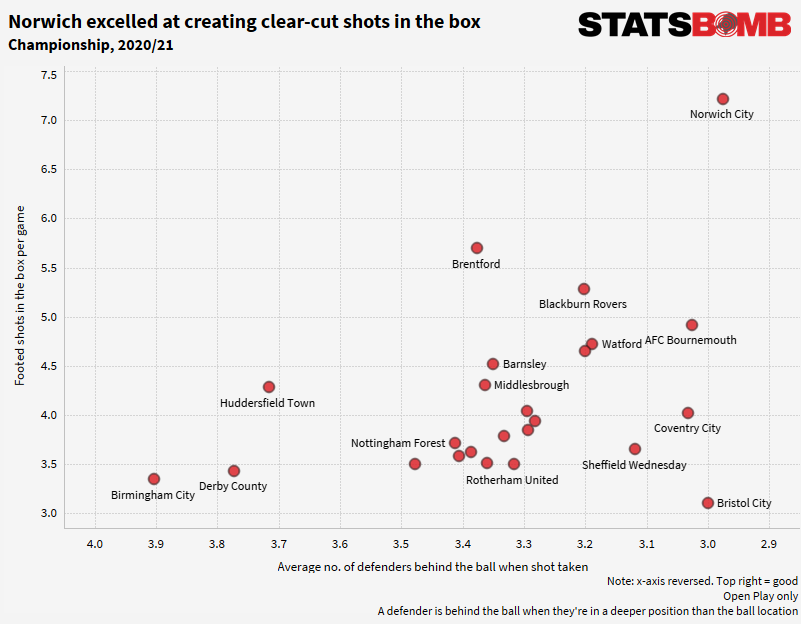 Out of possession they were organised, engaging the opposition higher up the pitch if the situation merited it but more often dropping in to defend from their own half. Norwich had the 17th-highest Defensive Distance in the Championship last season at 43.8 metres, the average distance from a team's own goal from which it makes defensive actions.
Out of possession they were organised, engaging the opposition higher up the pitch if the situation merited it but more often dropping in to defend from their own half. Norwich had the 17th-highest Defensive Distance in the Championship last season at 43.8 metres, the average distance from a team's own goal from which it makes defensive actions. 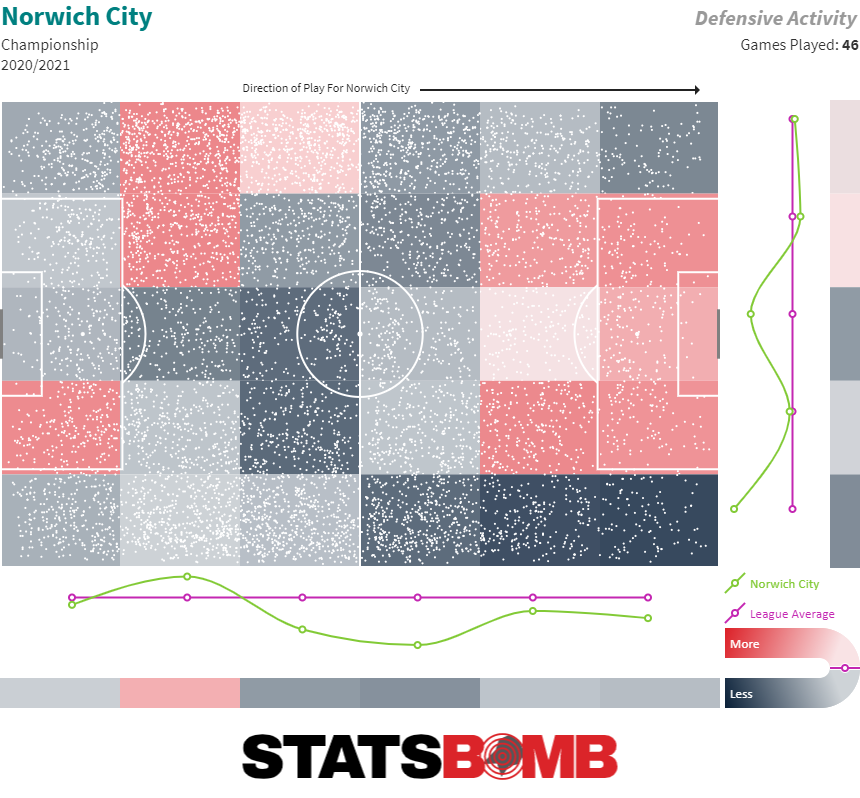 It’s a nod to Daniel Farke’s coaching ability that their high press, when they did engage in it, was highly effective, both in turning the ball over and in creating opportunities for them in attack. They made the 2nd-most shots following a high press, and forced the more counterpressure regains than anyone else in the league last season; counterpressure regains being regains that occurred within 5 seconds of a player counterpressing an opponent.
It’s a nod to Daniel Farke’s coaching ability that their high press, when they did engage in it, was highly effective, both in turning the ball over and in creating opportunities for them in attack. They made the 2nd-most shots following a high press, and forced the more counterpressure regains than anyone else in the league last season; counterpressure regains being regains that occurred within 5 seconds of a player counterpressing an opponent. 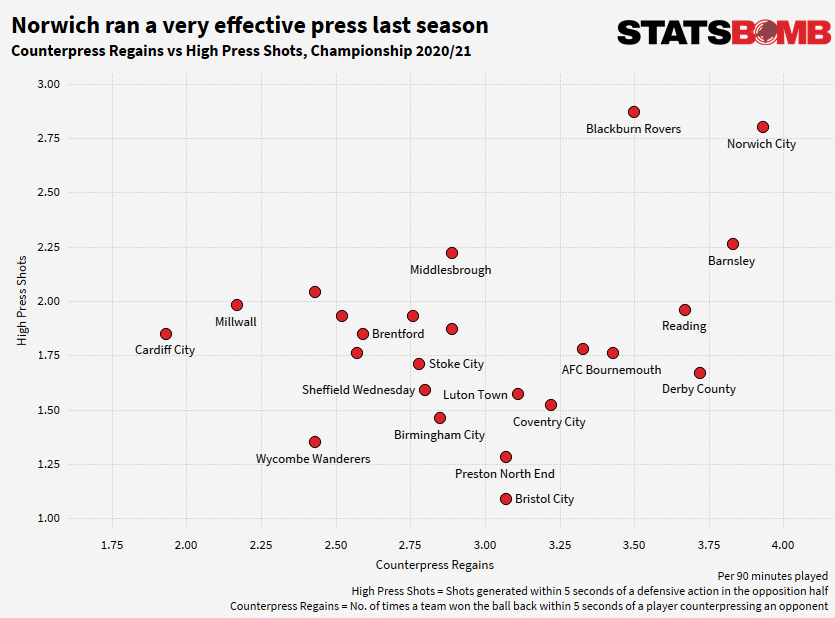 That Norwich conceded the fewest counterattacking shots in the league was as much down to the midfield pair of Oliver Skipp and Kenny McLean performing caretaking duties in front of the defence as it was the effective counterpress. Norwich weren’t shy of committing bodies forward, often attacking with six players if not more with the full-backs bombing on, so when the opposition did attempt to break from their own third, they found Skipp and McLean - with their names like a 70s buddy cop duo - taking no nonsense and pulling over any opposition attempts to break and enter. Personnel & Transfers Daniel Farke changed little about his team’s approach the last time they came up, drawing praise from football purists but ultimately falling short, relegated in 20th place and with a -49 goal difference. Change is anticipated this time around, with Farke reportedly looking to play with the handbrake on more often and prioritise Norwich’s defensive shape over their attacking fluidity. Knowing what we do about the ex-Dortmund II coach and the club’s overarching philosophy, this far from equates to a complete overhaul of the playing style, just tweaks and adjustments here and there to make the team as a whole more defensively robust. It’s expected that we could see Norwich drop the #10 and line up in a 4-3-3 with a bigger focus on transitions, as opposed to the 4-2-3-1 witnessed in every Farke season to date. This is likely to mean that… ok, ok, ok. I’ve gone on long enough. Time to talk about the elephant in the room. Emiliano Buendía. Last season Buendía put in one of the most impressive individual seasons ever seen in England’s second tier, often playing football that looked more suited to the Champions League than the Championship. As well as consistently dazzling and delighting the Norwich support with displays of ball mastery, the Argentinian showed why he’s developed a reputation as a feisty customer, biting at the ankles of his opponents and generally being an absolute nuisance out of possession. He completed the ‘double double’ – recording 15 goals and 14 assists – but also moved the ball to the final third more than any other player in the league (adjusted to a per 90 minutes rate) and recorded the most possession-adjusted pressures per 90 as well. There’s little this player doesn’t do. No surprise then that Aston Villa were keen to offer Norwich a fee that was the highest the Canaries have ever received for a player. It goes without saying that Buendía will be very difficult to replace. Which brings us to the squad additions. So far there’s been three key moves, the first being what looks to be Buendía’s replacement: Milot Rashica. Rashica doesn’t represent a direct like-for-like exchange and his signing backs up the theory that Norwich will emphasise attacking transitions this season. Signed from relegated Bundesliga club Werder Bremen, Rashica’s attacking versatility could make him an important player for Norwich this season. He’s predominantly a wide attacker, but has also spent time leading the line and in deeper central positions across his 3.5 Bundesliga seasons. Last season he put up reasonable shot (2.4 per 90) and dribble (2.5 per 90) volumes on a relegated side, and a defensive work rate is also visible in the data, particularly in previous seasons.
That Norwich conceded the fewest counterattacking shots in the league was as much down to the midfield pair of Oliver Skipp and Kenny McLean performing caretaking duties in front of the defence as it was the effective counterpress. Norwich weren’t shy of committing bodies forward, often attacking with six players if not more with the full-backs bombing on, so when the opposition did attempt to break from their own third, they found Skipp and McLean - with their names like a 70s buddy cop duo - taking no nonsense and pulling over any opposition attempts to break and enter. Personnel & Transfers Daniel Farke changed little about his team’s approach the last time they came up, drawing praise from football purists but ultimately falling short, relegated in 20th place and with a -49 goal difference. Change is anticipated this time around, with Farke reportedly looking to play with the handbrake on more often and prioritise Norwich’s defensive shape over their attacking fluidity. Knowing what we do about the ex-Dortmund II coach and the club’s overarching philosophy, this far from equates to a complete overhaul of the playing style, just tweaks and adjustments here and there to make the team as a whole more defensively robust. It’s expected that we could see Norwich drop the #10 and line up in a 4-3-3 with a bigger focus on transitions, as opposed to the 4-2-3-1 witnessed in every Farke season to date. This is likely to mean that… ok, ok, ok. I’ve gone on long enough. Time to talk about the elephant in the room. Emiliano Buendía. Last season Buendía put in one of the most impressive individual seasons ever seen in England’s second tier, often playing football that looked more suited to the Champions League than the Championship. As well as consistently dazzling and delighting the Norwich support with displays of ball mastery, the Argentinian showed why he’s developed a reputation as a feisty customer, biting at the ankles of his opponents and generally being an absolute nuisance out of possession. He completed the ‘double double’ – recording 15 goals and 14 assists – but also moved the ball to the final third more than any other player in the league (adjusted to a per 90 minutes rate) and recorded the most possession-adjusted pressures per 90 as well. There’s little this player doesn’t do. No surprise then that Aston Villa were keen to offer Norwich a fee that was the highest the Canaries have ever received for a player. It goes without saying that Buendía will be very difficult to replace. Which brings us to the squad additions. So far there’s been three key moves, the first being what looks to be Buendía’s replacement: Milot Rashica. Rashica doesn’t represent a direct like-for-like exchange and his signing backs up the theory that Norwich will emphasise attacking transitions this season. Signed from relegated Bundesliga club Werder Bremen, Rashica’s attacking versatility could make him an important player for Norwich this season. He’s predominantly a wide attacker, but has also spent time leading the line and in deeper central positions across his 3.5 Bundesliga seasons. Last season he put up reasonable shot (2.4 per 90) and dribble (2.5 per 90) volumes on a relegated side, and a defensive work rate is also visible in the data, particularly in previous seasons. 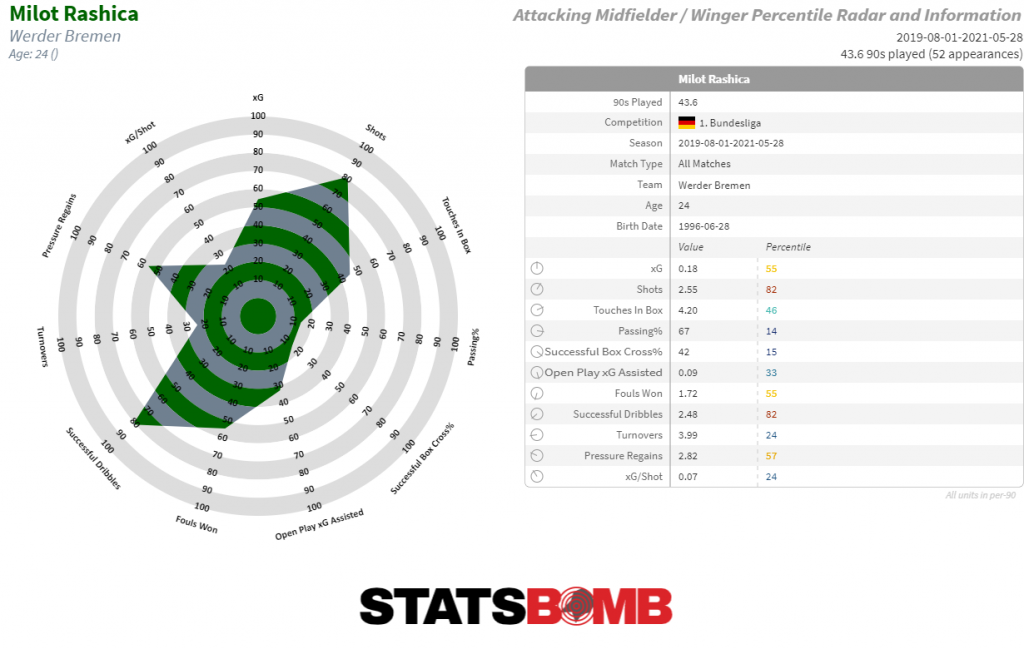 The second and third key moves are that of Billy Gilmour, signed on a season-long loan from Chelsea, and Pierre Lees Melou, who arrives from OGC Nice in Ligue 1. Gilmour’s burgeoning reputation makes his signing regarded as a bit of a coup. It’s highly likely Farke’s existing relationship with Thomas Tuchel – Farke was Dortmund II manager while Tuchel was there as first team manager -- played a key role in securing his signature, but Gilmour should be well suited to Norwich’s play as well, his technical ability should help to speed up those transitions through the midfield. Though the club still retains an interest in taking Championship Team of The Year entrant Oliver Skipp on loan from Tottenham again, the signing of Melou does add defensive reinforcement to the midfield. Curiously, Melou only moved into the professional game at the age of 22, jumping from France’s 5th tier to join Dijon in Ligue 2 in 2015, the equivalent of graduating from the National League to the Championship in one step. He switched to Nice after one Ligue 1 season with Dijon and has been a regular in the French top tier ever since, making 151 appearances over five seasons. Besides the years of experience in a top European league, there’s lots to like about Melou’s profile. Given he’ll be at the centre of Premier League midfield battles, an ability to play under pressure is essential, and it appears as though he should be capable of doing that: Melou’s Pressured Pass Completion % of 85% was the same clip as his regular, unpressured pass completion %. Norwich will also be looking for a defensive contribution from their new midfielder, and this is where it seems the Frenchman will excel. Melou was one of the most active defenders in Ligue 1 last season; compared to all central midfielders in the league, he ranked 12th for possession-adjusted tackles and interceptions. All in all, if he can translate these performances to the Premier League, this looks like it could be a very clever bit of business at the reported £3.5m fee.
The second and third key moves are that of Billy Gilmour, signed on a season-long loan from Chelsea, and Pierre Lees Melou, who arrives from OGC Nice in Ligue 1. Gilmour’s burgeoning reputation makes his signing regarded as a bit of a coup. It’s highly likely Farke’s existing relationship with Thomas Tuchel – Farke was Dortmund II manager while Tuchel was there as first team manager -- played a key role in securing his signature, but Gilmour should be well suited to Norwich’s play as well, his technical ability should help to speed up those transitions through the midfield. Though the club still retains an interest in taking Championship Team of The Year entrant Oliver Skipp on loan from Tottenham again, the signing of Melou does add defensive reinforcement to the midfield. Curiously, Melou only moved into the professional game at the age of 22, jumping from France’s 5th tier to join Dijon in Ligue 2 in 2015, the equivalent of graduating from the National League to the Championship in one step. He switched to Nice after one Ligue 1 season with Dijon and has been a regular in the French top tier ever since, making 151 appearances over five seasons. Besides the years of experience in a top European league, there’s lots to like about Melou’s profile. Given he’ll be at the centre of Premier League midfield battles, an ability to play under pressure is essential, and it appears as though he should be capable of doing that: Melou’s Pressured Pass Completion % of 85% was the same clip as his regular, unpressured pass completion %. Norwich will also be looking for a defensive contribution from their new midfielder, and this is where it seems the Frenchman will excel. Melou was one of the most active defenders in Ligue 1 last season; compared to all central midfielders in the league, he ranked 12th for possession-adjusted tackles and interceptions. All in all, if he can translate these performances to the Premier League, this looks like it could be a very clever bit of business at the reported £3.5m fee. 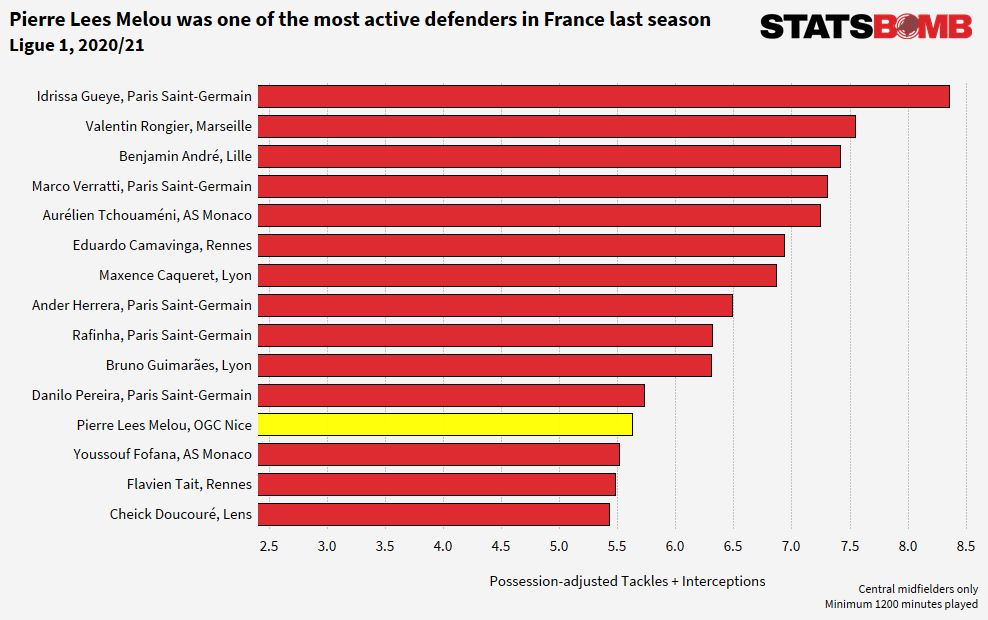 Projection The bad news is the sale of Buendía, but the good news is that there’s a strong sense that Norwich come into this Premier League season better prepared to make a good fist of avoiding relegation than the last time they were here, even without Buendía. Farke and co. will be under no illusions that this will likely be another season of struggle, but it feels as though everyone at the club is richer for the experience of the 2019/20 season, and arrive ready to fight smarter in this campaign. The points spreads are backing them to beat their points tally from last time with the line set at 36.25, a total that makes them 2nd favourites to go down but one that also puts them within range of their relegation rivals and well capable of survival. It’s a challenge no doubt, but Farke’s men ride again.
Projection The bad news is the sale of Buendía, but the good news is that there’s a strong sense that Norwich come into this Premier League season better prepared to make a good fist of avoiding relegation than the last time they were here, even without Buendía. Farke and co. will be under no illusions that this will likely be another season of struggle, but it feels as though everyone at the club is richer for the experience of the 2019/20 season, and arrive ready to fight smarter in this campaign. The points spreads are backing them to beat their points tally from last time with the line set at 36.25, a total that makes them 2nd favourites to go down but one that also puts them within range of their relegation rivals and well capable of survival. It’s a challenge no doubt, but Farke’s men ride again.
Want to read about another team? The rest of our Premier League season previews can be found here If you're a club, media or gambling entity and want to know more about what StatsBomb can do for you, please contact us at Sales@StatsBomb.com We also provide education in this area, so if this taste of football analytics sparked interest, check out our Introduction to Football Analytics course Follow us on Twitter in English and Spanish and also on LinkedIn
